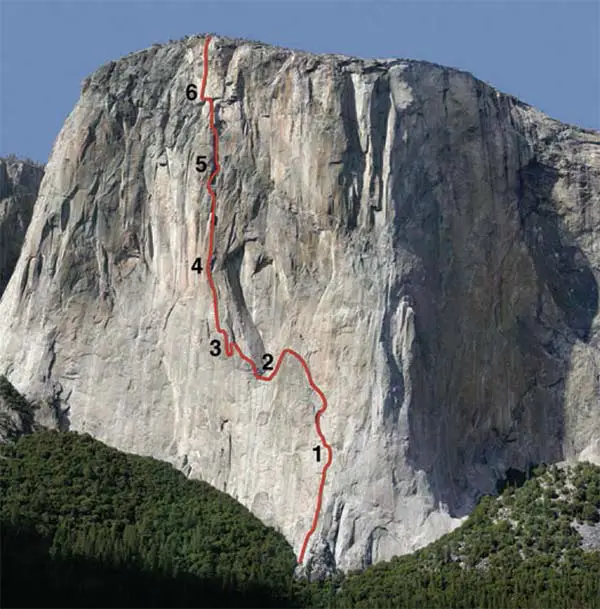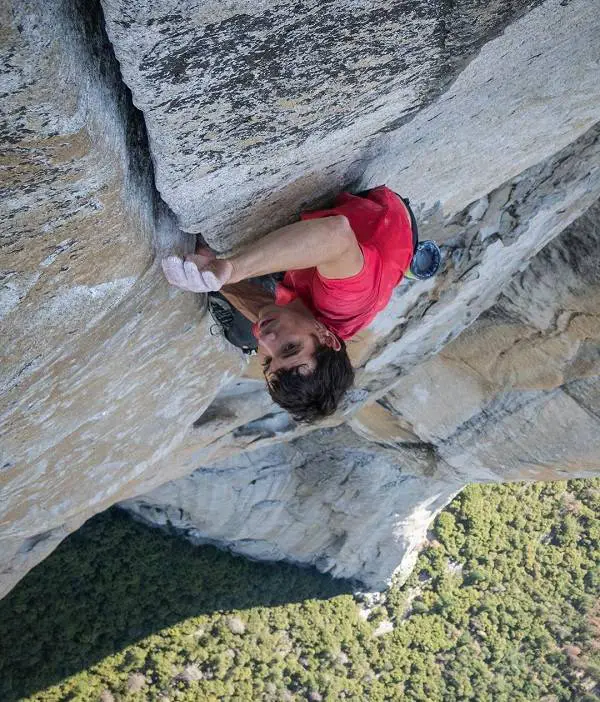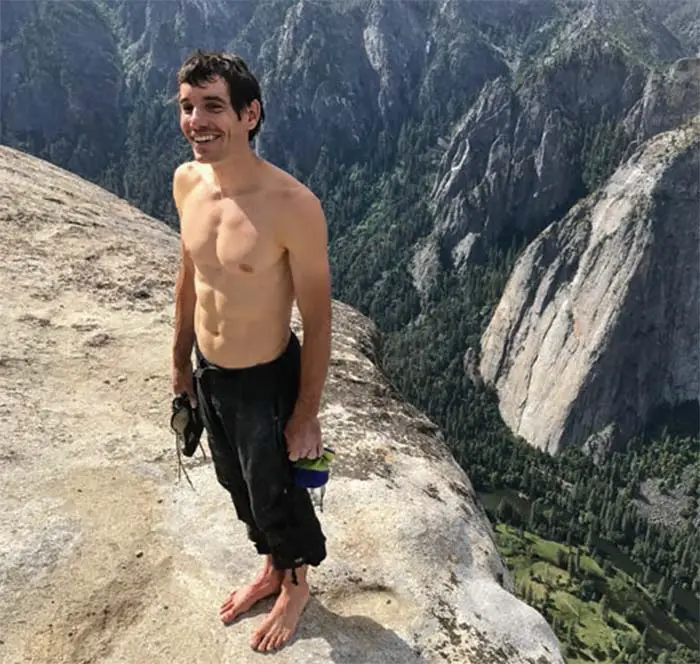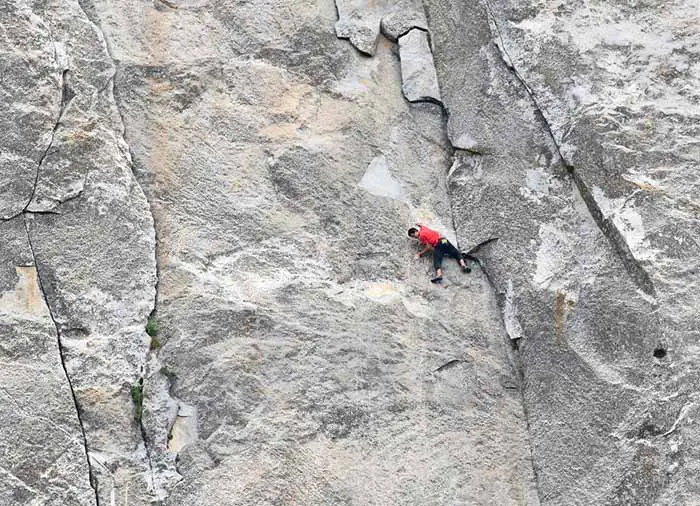
Ascent Log
| Climber | Suggested Grade | Date of Ascent | Notes |
|---|---|---|---|
| Alex & Thomas Huber | 5.13a | May 1998 | Alex noticed Freerider when he was on the hunt for an easier route up Salathe Wall. Along with his brother, they became the first climbers to free climb Freerider. Planet Mountain |
| Alex Honnold | 5.13a | 3rd June 2017 | This was a historic ascent that millions of people got to witness through the documentary, Free Solo. Video |
| Steph Davis | 5.13a | 24th Apr 2004 | Steph became the first woman to free climb Freerider and the third woman to free El Cap. Climbing Magazine |
| Calum Coldwell-Story | 5.13a | Oct 2016 | Calum was close to onsighting Freerider. He fell on the last move of the boulder problem. |

Climb Profile
The Route
For reasons not hard to comprehend, El Capitan – an incomprehensibly massive granite cliff in Yosemite Valley – is threaded with hundreds of world class routes. Freerider sits off to the left side of The Nose, El Cap’s premier buttress, and tops out at 3,300 feet/30 pitches above the valley floor.

The first 8 pitches comprise of The Freeblast Slab, a stand-alone Yosemite classic that ends at a large ledge called the Mammoth Terraces. The more difficult pitches are higher up. In relative terms, this is the easiest free route on El Capitan with most of the pitches clocking in at 5.11+ or lower. The crux pitch is 5.13a.
First Ascent
May 1998: Alex and Thomas Huber
Alex and Thomas Huber, originally from Germany, were some of the most influential climbers in Yosemite during the 1990s. In terms of big wall climbing, they are two of the most prolific in history. At a time when many of El Cap’s classic aid routes were seeing first free ascents, the Huber brothers formed the vanguard of the free-climbing movement.
During a climb of the Salathé Wall on El Cap’s Southwest face, Alex first noticed an alternate crack system that subverted the harder pitches on the Salathé Wall. While his goal at that time was to complete the first redpoint ascent of Salathé, a few of the harder pitches had succeeded in pushing him back. Being relatively new to crack climbing, he wondered if there was an easier way to climb the route.

He rappelled in from the top of the formation to examine what he thought could be an easier variation. Armed with a rope solo device and fixed lines, he immediately sent the new pitches. While the route was now “established,” he still needed to climb them on lead.
A shortage of partners motivated enough to join him precluded a ground-up first ascent attempt until 1998. In the intervening years, Alex completed his original objective: the first redpoint ascent of the Salathé Wall in 1995. He led all of the pitches himself. Then, in May of ’98 – after a few years spent abroad in Europe and the Middle East – he and his brother Thomas returned to Yosemite.
Shortly after completing the first free ascent of El Niño (5.13c), the brothers approached Freerider. The route was completed in a day, making the Hubers the second and third people behind Lynn Hill to free-climb a route on El Capitan in a day.
Freerider, being the easiest free-climb on El Capitan, instantly became a valley classic. The second, third and 40th ascents quickly followed and, inevitably, it soon became another variable in the quest for “the next big thing.” Alex even entertained the idea of someday climbing the route free solo, but ultimately decided that it would be difficult; that was an undertaking for future generations. Namely, for someone like Alex Honnold.
First Free Solo Ascent
3rd June 2017: Alex Honnold
We couldn’t talk about Freerider without mentioning the obvious. In June 2017, Alex Honnold, the best free solo climber, stunned the world with his daring free solo ascent of Freerider. He stepped over the summit in just under four hours, a feat that left both the climbing community and the world in awe.

In the fall of 2016, Honnold moved to Yosemite to focus on his preparation. His preparation however was cut short after Sanni McCandless (now wife) dropped him while belaying him on Freeblast. Alex ended up spraining his ankle and had to climb with a bandage.
His first attempt to free solo Freerider came in late 2016, but it didn’t go quite as planned. On a 5.11 slab up Freeblast, Alex got panicked and grabbed a bolt. The camera crew gave him a sling and carabiner which he used with a munter hitch. He rappelled up to Mammoth Terrace.
Alex spent the winter and spring seasons climbing Freerider with ropes, memorizing each move, each hold, and each crux. He made dozens of ascents with protective gear, each time refining his movements, memorizing his path, and building his confidence. On June 3rd, at 5:32 am, Alex made his first move. By 9:28 am, he was at the top. This was by far one of his hardest free solo ascents, not just for the grade, but mentally.

Legacy
Freerider has achieved an unofficial status as “The Astroman for the new generation.” Astroman on the east face of Washington column was free climbed in 1975, twenty years before Alex Huber’s FFA of Freerider. At the time, it represented a new milestone in free climbing – it was the first significant big wall to be sent free and, in effect, it jettisoned the sport into a new age of progression. As the years have proved, Freerider has taken up the mantel of a route that sets the bar.

Freerider, seemingly gifted with some sort of sender magic that recurs only once every twenty years, subsequently consented to grant Alex Honnold safe passage to the top in 2017, making him the first person in history to free-solo El Capitan. Alex Huber in an interview with Planet Mountain said:
“I knew [Alex Honnold] was someone mentally strong enough to do it, so I also knew that if the right moment were to come along, that if the stars aligned, he would do it. What an amazing achievement!”
There is no arguing that Freerider has gone down in history as one of the most iconic routes.

Video Library



